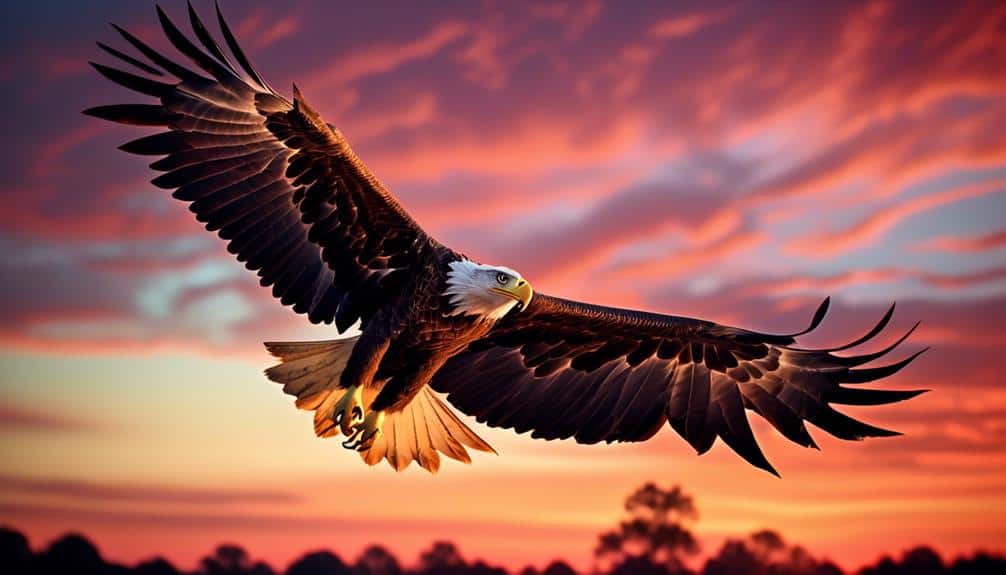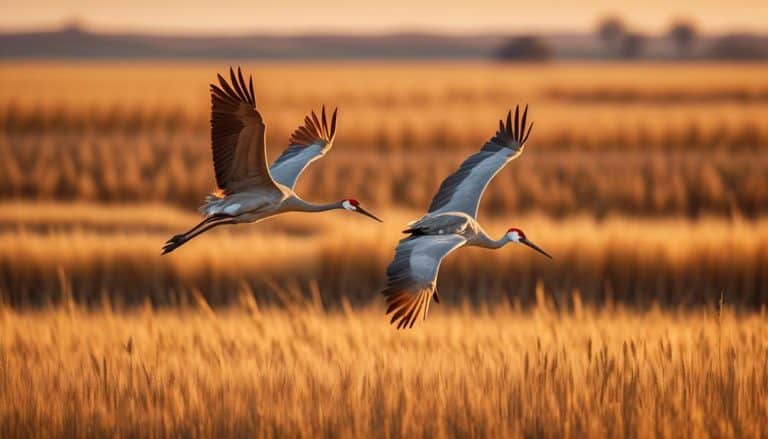As I was strolling through the lush marshlands of South Carolina, little did I know that I was about to witness a breathtaking display of nature's raw power and beauty.
Birds of prey, with their keen eyes and razor-sharp talons, command both my fascination and respect. In this diverse state, home to a wide variety of habitats, a remarkable array of these majestic creatures can be found.
From the iconic Bald Eagles soaring through the sky to the stealthy Red-Tailed Hawks silently gliding above, South Carolina offers a haven for these incredible hunters.
Join me on a journey as we unravel the secrets of these magnificent birds and discover the untold stories that lie within their wings.
Bald Eagles: Symbol of Strength and Majesty
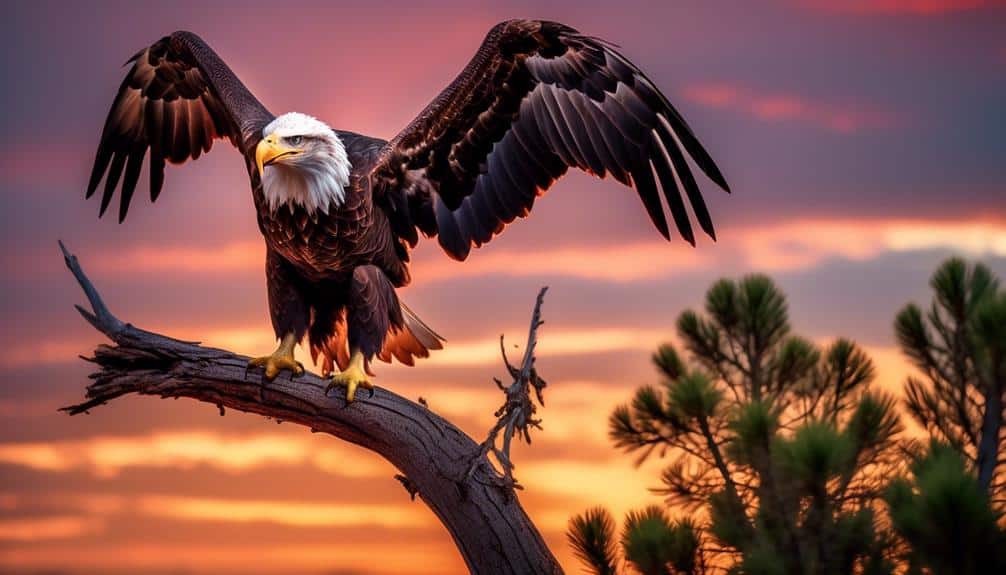
Bald Eagles, with their majestic presence and awe-inspiring strength, are revered as a symbol of power and prestige in South Carolina's avian community. These magnificent birds, once on the brink of extinction, have made a remarkable conservation comeback in recent decades. Their recovery is nothing short of a success story, as the population of bald eagles has soared from a mere handful to over 300 breeding pairs in the state.
The cultural significance of bald eagles can't be overstated. They've long been an emblem of national pride, representing freedom and resilience. In South Carolina, they hold a special place in the hearts of locals, symbolizing the state's natural beauty and environmental stewardship.
Bald eagles are easily recognizable with their white-feathered heads, dark brown bodies, and striking yellow beaks. They're highly skilled hunters, primarily feeding on fish, which they catch by swooping down from great heights and snatching them from the water's surface with their powerful talons.
Observing these regal creatures in their natural habitat is a truly awe-inspiring experience. Whether perched on a tall tree branch or soaring through the sky, their graceful flight and commanding presence leave a lasting impression. Their return to South Carolina's skies isn't only a conservation success story but also a testament to the resilience and dedication of those working to protect and preserve our natural heritage.
Red-Tailed Hawks: Masters of Stealth and Precision
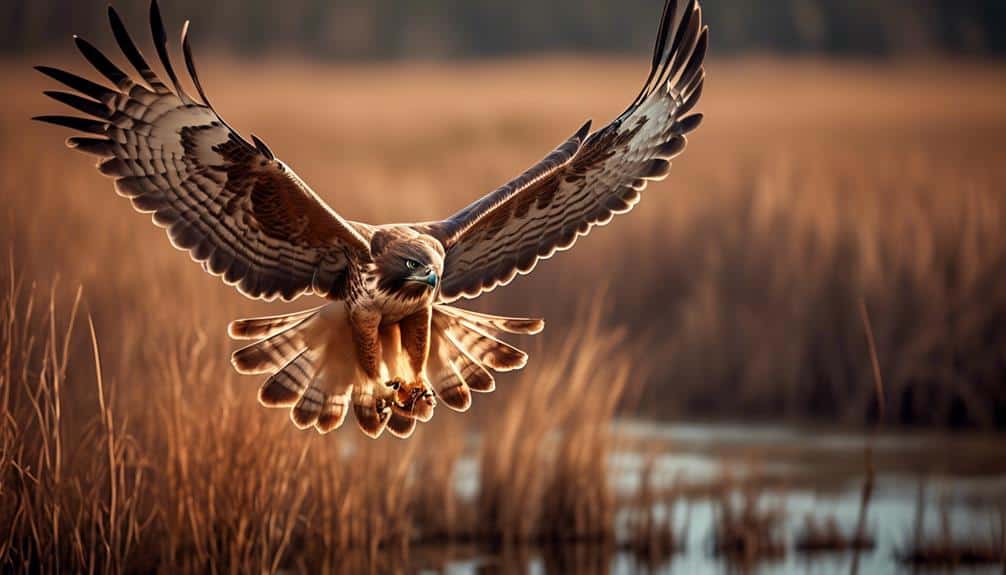
What makes Red-Tailed Hawks masters of stealth and precision? These magnificent birds are known for their exceptional hunting skills, making them stealthy hunters and precise predators. As I observe them in the wild, I'm in awe of their ability to blend seamlessly into their surroundings, a testament to their remarkable stealth. Their plumage, predominantly reddish-brown with a distinct red tail, provides excellent camouflage against the backdrop of trees and grasses.
Red-Tailed Hawks exhibit incredible precision in their hunting techniques. With keen eyesight and sharp talons, they're able to pinpoint their prey from great distances. As they soar through the sky, they carefully scan the ground below, searching for any movement that may indicate potential prey. Once they spot their target, they swiftly dive towards it, using their powerful wings to maintain control and accuracy.
I have witnessed their precision firsthand as they swoop down and snatch small mammals, reptiles, or even other birds with astonishing accuracy. Their talons lock onto their prey with a vice-like grip, ensuring that their catch doesn't escape. It's fascinating to observe the grace and efficiency with which they strike, leaving little chance for their prey to escape.
Red-Tailed Hawks are truly masters of stealth and precision. Their ability to blend in with their surroundings and their remarkable hunting skills make them formidable predators in the avian world. It's a privilege to witness these majestic birds in action, as they demonstrate their mastery of the art of hunting.
Great Horned Owls: Silent Hunters of the Night
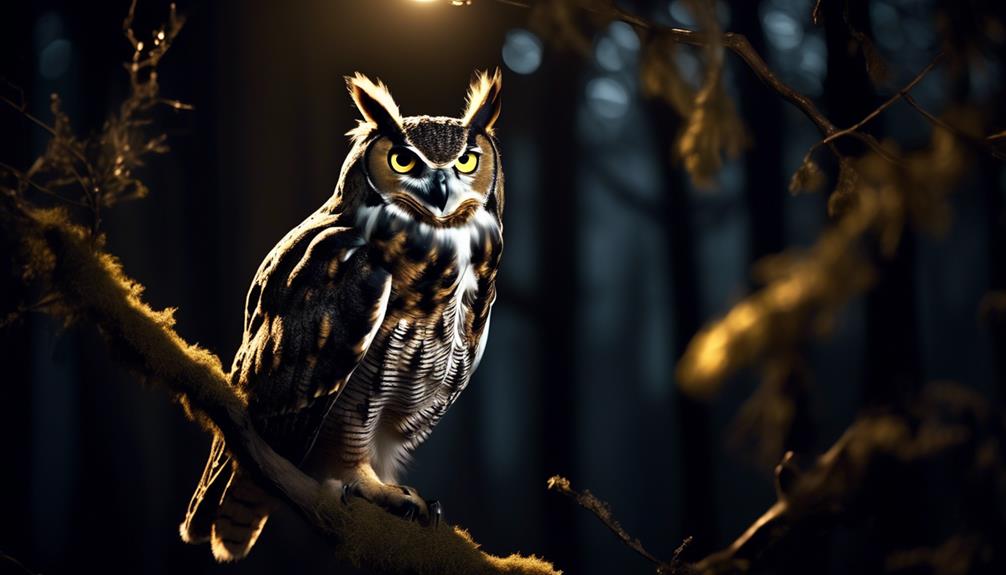
As I continue my exploration of the remarkable birds of prey in South Carolina, my attention now turns to the Great Horned Owls, fascinating creatures known for their silent hunting prowess under the cover of night. These nocturnal predators possess incredible adaptations that enable them to hunt with remarkable efficiency in the dark.
Great Horned Owls are silent hunters, relying on their exceptional hearing and vision to locate prey in the darkness. Their large, forward-facing eyes provide excellent depth perception, allowing them to accurately judge distances even in low light conditions. The arrangement of their feathers also plays a crucial role in their silent approach. The leading edge of their flight feathers is serrated, which reduces aerodynamic noise and enables them to fly almost silently through the night sky.
This silent approach is further enhanced by their keen hearing. The asymmetrical positioning of their ears allows them to pinpoint the exact location of small prey, such as mice or rabbits, even in complete darkness. Their ability to rotate their heads up to 270 degrees also contributes to their hunting success, as it allows them to quickly scan their surroundings without having to move their bodies.
To illustrate the silent hunting prowess of Great Horned Owls, let's take a look at the following table showcasing their unique adaptations:
| Adaptation | Function |
|---|---|
| Forward-facing eyes | Accurate depth perception in low light conditions |
| Serrated flight feathers | Reduction of aerodynamic noise during flight |
| Asymmetrical ears | Pinpointing the exact location of prey |
| 270-degree head rotation | Quick scanning of the surroundings without body movement |
Great Horned Owls are truly remarkable creatures, perfectly adapted to be the masters of the night. Their silent hunting abilities and impressive adaptations make them one of the most formidable predators in the avian world.
Ospreys: Skilled Fishermen of South Carolina's Coastline
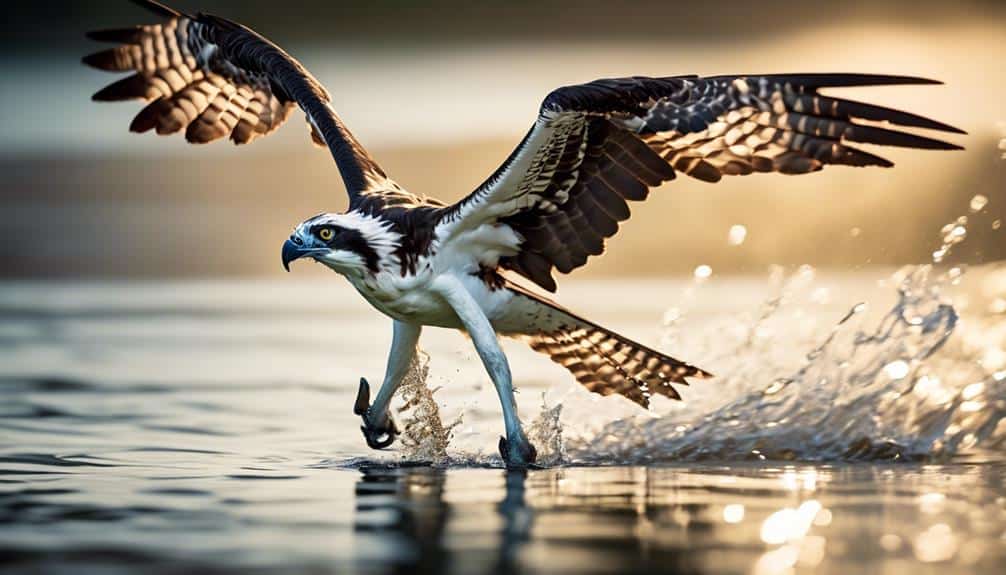
How do Ospreys utilize their incredible fishing skills along the coastline of South Carolina? Ospreys, also known as fish hawks, are renowned for their exceptional ability to catch fish from the water. Along the coast of South Carolina, these skilled fishermen showcase their impressive hunting techniques as they dive into the water to snatch their prey.
Here are three ways in which Ospreys utilize their fishing skills along the coastline of South Carolina:
- Exceptional Hunting Technique: Ospreys have adapted for their piscivorous lifestyle with unique physical attributes. Their sharp, curved talons and spiny foot pads enable them to grip slippery fish securely. Moreover, their reversible outer toes allow them to grasp their prey with two toes in front and two behind, ensuring a firm hold.
- Osprey Migration Patterns: South Carolina serves as a crucial stopover point for Ospreys during their migration. These birds undertake long journeys, traveling from their breeding grounds in North America to their wintering grounds in Central and South America. The coastline of South Carolina provides abundant food sources for the migrating Ospreys, making it an essential resting and feeding area.
- Osprey Conservation Efforts: Due to habitat loss, pollution, and human disturbance, Osprey populations have faced significant declines in the past. However, thanks to conservation efforts and the protection of nesting sites, their numbers have rebounded. Organizations such as the South Carolina Department of Natural Resources and local birdwatching groups actively work to conserve Osprey populations and their coastal habitats.
Observing Ospreys in action along the coastline of South Carolina is truly awe-inspiring. Their remarkable fishing skills, coupled with their migratory patterns and conservation efforts, make them a remarkable species worth protecting.
Peregrine Falcons: Fastest Birds in the World
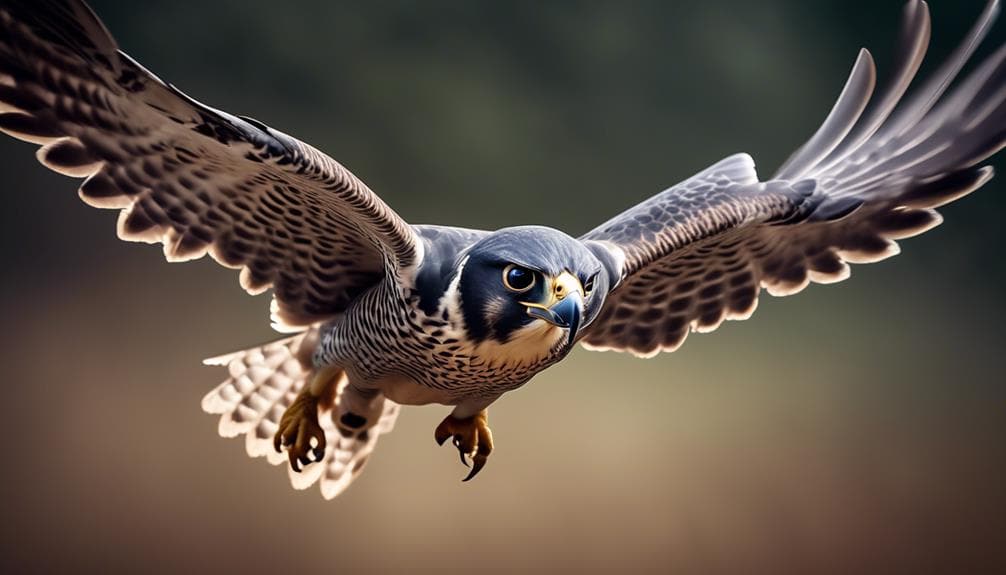
After witnessing the impressive fishing skills of Ospreys along the coastline of South Carolina, it's fascinating to shift our focus to another remarkable species of birds: the Peregrine Falcons, known as the fastest birds in the world.
Peregrine falcons are renowned for their incredible hunting speed, reaching astonishing velocities during their hunting dives, or stoops. With a maximum speed recorded at over 240 miles per hour, these birds are considered the fastest animals on the planet.
Their unique breeding habits also make them an intriguing species to study. Peregrine falcons are known for their monogamous relationships and strong pair bonds. They typically mate for life, with both males and females actively participating in the courtship displays. The courtship includes aerial acrobatics, with the male performing impressive flight maneuvers to impress the female.
Peregrine falcons prefer nesting on cliffs and high structures, such as skyscrapers and tall buildings. They construct their nests, called eyries, using twigs, grass, and other materials. The female lays a clutch of three to four eggs, which are incubated by both parents for about a month. Once hatched, the chicks are fed regurgitated food by the parents until they're ready to fly and hunt on their own.
Studying the hunting speed and breeding habits of Peregrine Falcons provides valuable insights into their remarkable adaptations and behaviors. These birds continue to captivate researchers and bird enthusiasts alike with their incredible speed and unique reproductive strategies.
Frequently Asked Questions
What Is the Population of Bald Eagles in South Carolina?
I don't have enough context to answer the question about the population of bald eagles in South Carolina, but I can tell you that bald eagle conservation efforts and understanding their nesting habits are important for their survival.
How Do Red-Tailed Hawks Communicate With Each Other?
Red-tailed hawks communicate through a variety of vocalizations, such as screeching and whistling. These vocalizations serve to establish territories and attract mates. Their territorial behavior is fascinating to observe, as they fiercely defend their hunting grounds.
What Is the Average Wingspan of a Great Horned Owl?
The average wingspan of a great horned owl is around 4 to 5 feet. These majestic birds are known for their impressive hunting skills and can be found in a variety of habitats, from forests to open fields.
How Deep Can Ospreys Dive While Hunting for Fish?
When hunting for fish, ospreys dive with astonishing precision, plummeting into the depths like a fearless arrow. This hunting technique showcases the osprey's remarkable adaptability, although the impact of diving on its body remains a fascinating subject for scientific inquiry.
What Is the Top Speed of a Peregrine Falcon in Flight?
The top speed of a peregrine falcon in flight is impressive. It can reach speeds of over 240 miles per hour. This incredible velocity allows them to efficiently hunt their prey and contributes to their successful conservation efforts.
Conclusion
As the sun sets over the vast marshlands of South Carolina, I'm left in awe of the magnificent birds of prey that call this place home.
From the majestic Bald Eagles soaring through the skies to the stealthy Red-Tailed Hawks hunting their prey, each bird possesses a unique beauty and skill.
They're the poets of the sky, painting the air with their elegant movements and reminding us of the untamed wonders of nature.

